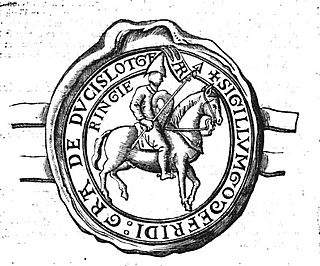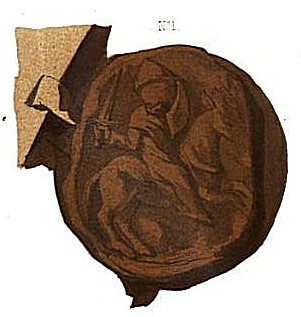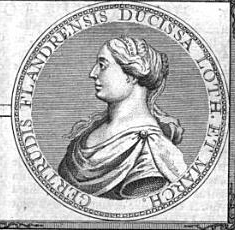
The Counts of Louvain were a branch of the Lotharingian House of Reginar which from the late 10th century ruled over the estates of Louvain ( French ) or Leuven ( Dutch ) in Lower Lorraine.

The Counts of Louvain were a branch of the Lotharingian House of Reginar which from the late 10th century ruled over the estates of Louvain ( French ) or Leuven ( Dutch ) in Lower Lorraine.
The likely ancestor of the Reginars, Gilbert, Count of the Maasgau, a vassal of the West Frankish king Charles the Bald, married a daughter of the Carolingian emperor Lothair I in 846. Reginar I "longneck", possibly his son, was the most powerful noble in the now kingless kingdom of Lotharingia (Lorraine), in the period from 910 to 915. His son and successor Gilbert swore fealty to the East Frankish king Henry the Fowler in 925 and three years later married his daughter Gerberga of Saxony. His younger brother's son Reginar III held lands in the region of Mons.
About 990, Lambert the Bearded (d. 1015), son of Count Reginar III, married Gerberga, daughter of the Carolingian duke Charles of Lower Lorraine, and by 1003 he was being described as a Count of Louvain. His county, with its original capital of Louvain built upon the Dyle river, between the old Pagus of Brabant and Pagus of Hasbania, rapidly increased in size and power. In 1013, Lambert annexed part of the county of Bruningrode, located between Louvain and Tienen, and this became a source of long-running conflict with the prince-bishops of Liège.
Lambert's family gained great influence in the Holy Roman Empire, acquiring more comital titles over time. His son Lambert II is also mentioned as a count of Brussels, where he had the St. Michael's Church erected to house the relics of Saint Gudula. When he joined the rebellion of Count Baldwin V of Flanders against Emperor Henry III, he was killed in a 1054 battle at Tournai.
Lambert's grandson, Count Henry III of Louvain was vested with the title of a Landgrave of Brabant upon the death of the Ezzonid count palatine Hermann II of Lotharingia in 1085.
In the early 12th century, Henry III was succeeded by his brother Godfrey I, who was entrusted with the imperial Dukedom of Lower Lotharingia, and Margraviate of Antwerp after Henry of Limbourg fell out of favour. Although the title was later given back to the lords of Limbourg-sur-Vesdre, Godefrey and his family refused to stop using the title, and kept possession of Antwerp. The ensuing conflict between the families led to the eventual abolishment of the Duchy, and the two families came to be known as the Dukes of Brabant and Limbourg respectively.
From 1183 onwards, the titles of Count of Louvain, Count of Brussels and Landgrave of Brabant were merged in the title of Duke of Brabant and used as appanages.

Lotharingia was a medieval successor kingdom of the Carolingian Empire. It comprised present-day Lorraine (France), Luxembourg, Saarland (Germany), Netherlands, and the eastern half of Belgium, along with parts of today's North Rhine-Westphalia (Germany), Rhineland-Palatinate (Germany) and Nord (France). It was named after King Lothair II, who received this territory after the Kingdom of Middle Francia of his father, Lothair I, had been divided among his three sons in 855.

The Duke of Brabant was the ruler of the Duchy of Brabant since 1183/1184. The title was created by the Holy Roman Emperor Frederick Barbarossa in favor of Henry I of the House of Reginar, son of Godfrey III of Leuven. The Duchy of Brabant was a feudal elevation of the existing title of landgrave of Brabant. This was an Imperial fief which was assigned to Count Henry III of Leuven shortly after the death of the preceding count of Brabant, Herman II of Lotharingia. Although the corresponding county was quite small its name was applied to the entire country under control of the dukes from the 13th century on. In 1190, after the death of Godfrey III, Henry I also became duke of Lotharingia. Formerly Lower Lotharingia, this title was now practically without territorial authority, but was borne by the later dukes of Brabant as an honorific title.

Lothair, sometimes called Lothair II, III or IV, was the penultimate Carolingian king of West Francia, reigning from 10 September 954 until his death in 986.

The County of Hainaut, sometimes spelled Hainault, was a territorial lordship within the medieval Holy Roman Empire that straddled the present-day border of Belgium and France. Its most important towns included Mons, now in Belgium, and Valenciennes, now in France.

Godfrey I, called the Bearded, the Courageous, or the Great, was the Landgrave of Brabant, Count of Brussels and Leuven (Louvain) from 1095 to his death and Duke of Lower Lorraine from 1106 to 1129. He was also Margrave of Antwerp from 1106 to his death.

Godfrey III was count of Louvain, landgrave of Brabant, margrave of Antwerp, and duke of Lower Lorraine from 1142 to his death.

The Duchy of Brabant, a state of the Holy Roman Empire, was established in 1183. It developed from the Landgraviate of Brabant of 1085–1183, and formed the heart of the historic Low Countries. The Duchy comprised part of the Burgundian Netherlands from 1430 and of the Habsburg Netherlands from 1482, until it was partitioned after the Dutch revolt of 1566–1648.
Henry I was the count of Limburg and Arlon from 1082 to his death and duke of Lower Lorraine between 1101 and 1106. His mother was Jutta, daughter of Frederick, Duke of Lower Lorraine, and his father is uncertain, but possibly named Count Udon.

Georg Donatus, Hereditary Grand Duke of Hesse was the first child of Ernest Louis, Grand Duke of Hesse, and his second wife, Princess Eleonore of Solms-Hohensolms-Lich. He was a nephew of Empress Alexandra and Emperor Nicholas II of Russia.

Henry III of Louvain, was Count of Louvain (Leuven) and Landgrave of Brabant, son of Henry II, Count of Louvain and Brussels, and Adela of Orthen, a daughter of Count Everard of Orthen.
Count Lambert "the Bearded" was the first person to be described as a count of Leuven in a surviving contemporary record, being described this way relatively late in life, in 1003. He is also the patrilineal ancestor of all the future counts of Leuven and dukes of Brabant until his descendant John III, Duke of Brabant, who died in 1355.

The Reginarids were a family of magnates in Lower Lotharingia during the Carolingian and Ottonian period. Their modern name is derived from the personal name which many members of the family bore, and which is seen as a Leitname of the family. At least two Dukes of Lotharingia in the 10th century belonged to this family. After a period of exile and rebellion, the two brothers who returned to power founded the first dynasties of the County of Hainault and County of Louvain. The latter were ancestors of the House of Brabant, Landgraves and later Dukes of Brabant, Lothier and Limburg. The Reginarid Brabant dynasty ended in 1355, leaving its duchies to the House of Luxembourg which in turn left them to the House of Valois-Burgundy in 1383. Junior branches of the male line include the medieval male line of the English House of Percy, Earls of Northumberland, and the German House of Hesse which ruled Hesse from 1264 until 1918, included King Frederick of Sweden and still exists today.

Lambert II was count of Leuven between 1033 and 1054. Lambert was the son of Lambert I of Louvain.
Henry I was the Count of Louvain from 1015 until 1038. He was a member of the House of Reginar.
Henry II was the Count of Louvain (Leuven) from 1054 through 1071 (?). Henry II was the son of Lambert II, Count of Louvain and Oda of Verdun. His maternal uncles included Pope Stephen IX and Duke Godfrey the Bearded of Lorraine.
The Margraviate of Antwerp consisted since the eleventh century of the area around the cities of Antwerp and Breda.

Gertrude of Flanders, was a Countess of Louvain and Landgravine of Brabant by marriage to Henry III, Count of Leuven, and a Duchess of Lorraine by marriage to Theodoric II, Duke of Lorraine. At the time the duchy was the upper Lorraine, since 959 separated from the duchy of Lower Lorraine.
Herman of Ename, was a count in what is now Belgium, who was responsible to the emperor for holding the frontier fort at Ename in the Pagus of Brabant, which faced the County of Flanders in the Kingdom of France.